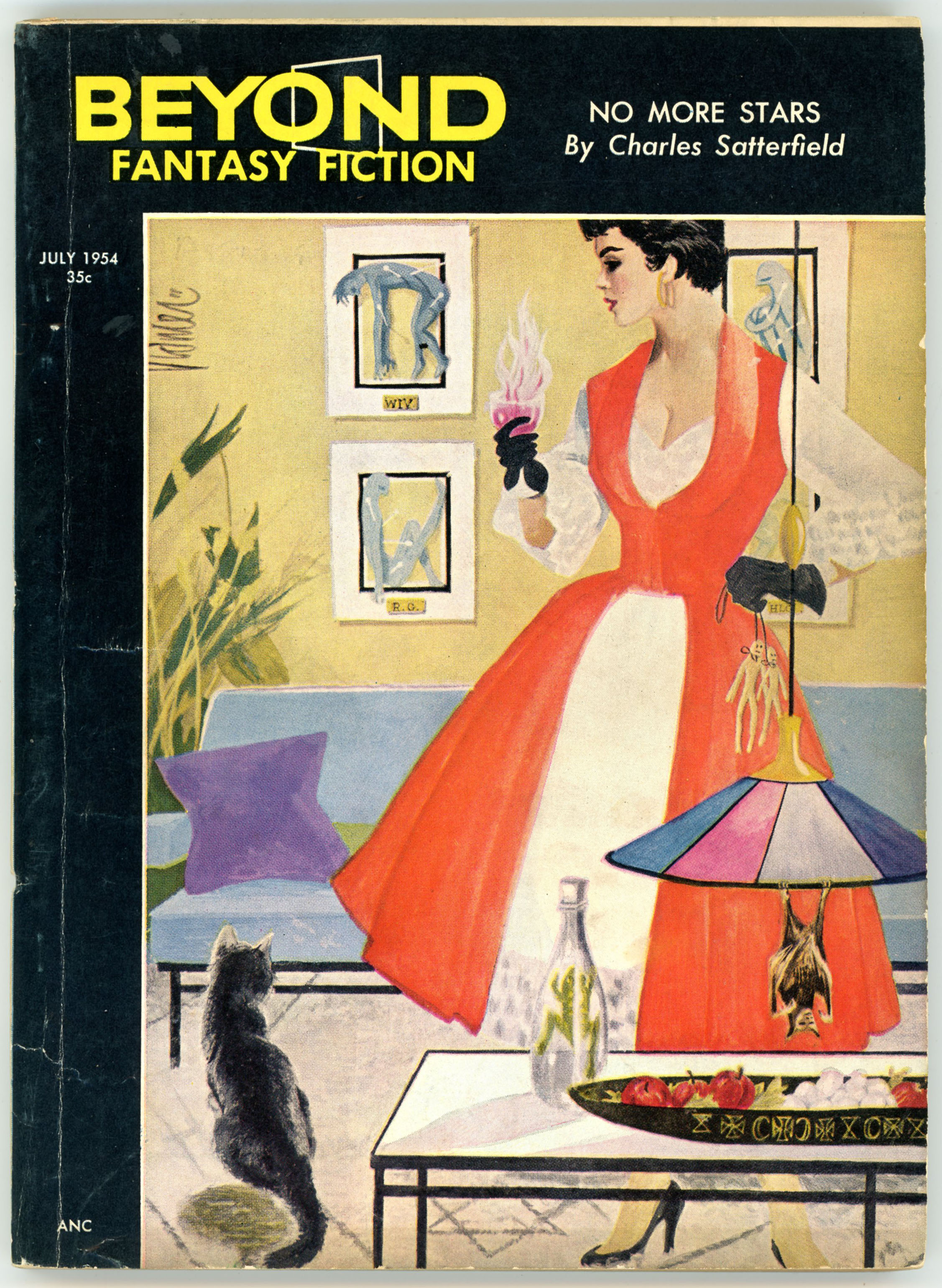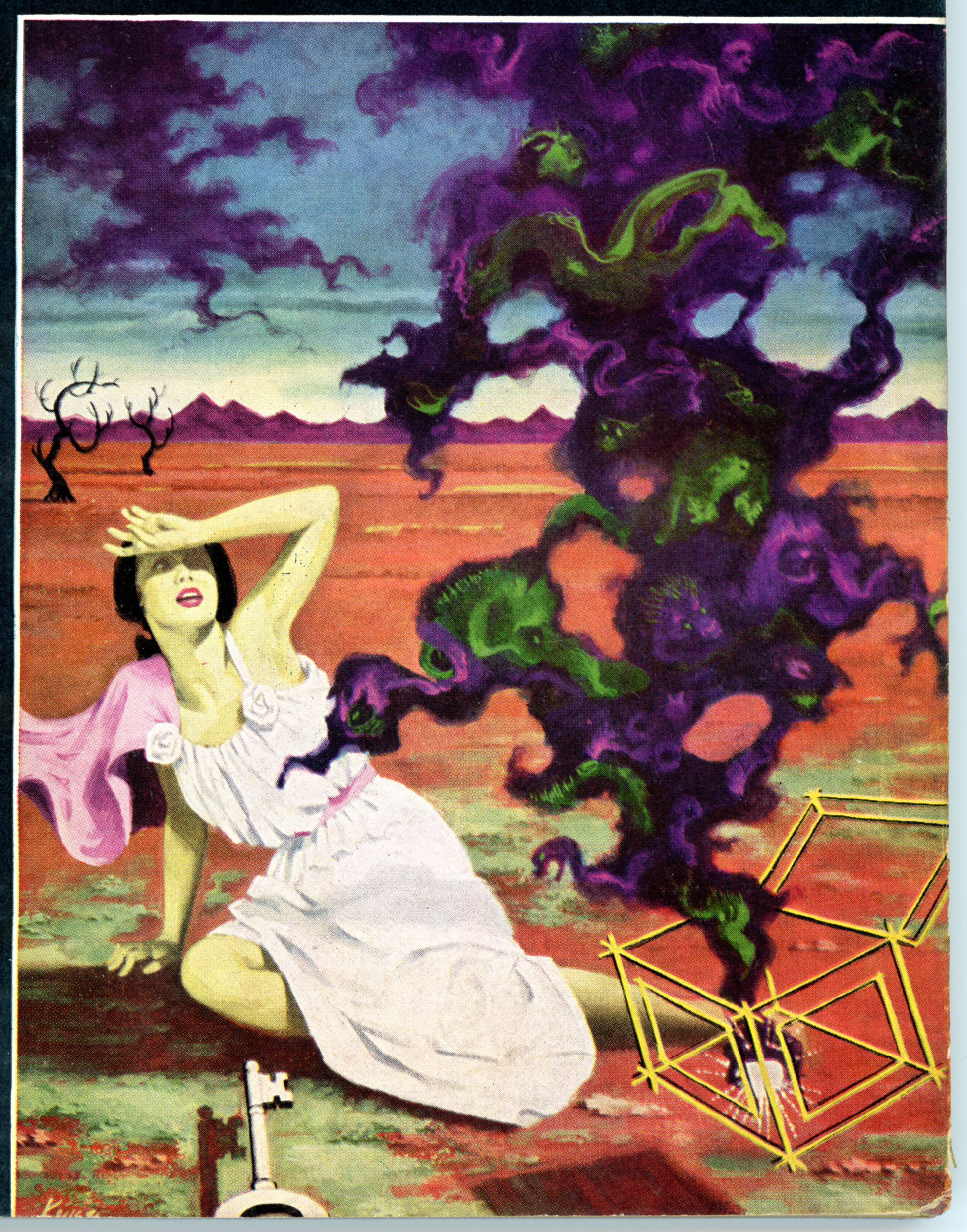[This post dates to September of 2018, and – here updated – includes a closer view of Rene Vidmer’s cover art.]
 Typical for Beyond Fantasy Fiction, the cover illustration is purely symbolic, having no relation to the magazine’s content: In this case, a lady – her hair in a rather 50s “do”, wearing a boldly orange-red dress with a prominent white center – seems to be a modern-day incarnation of witch. That is, of course, a witch avant-garde…
Typical for Beyond Fantasy Fiction, the cover illustration is purely symbolic, having no relation to the magazine’s content: In this case, a lady – her hair in a rather 50s “do”, wearing a boldly orange-red dress with a prominent white center – seems to be a modern-day incarnation of witch. That is, of course, a witch avant-garde…
The painting includes evidence of her occupation: Black cat, watching. Frog (or toad?) desperately trying to escape from a stoppered bottle. On the wall behind her, three framed gray human figures in bas-relief, all uncomfortably perforated by pins: Voodoo going on here? (A close look shows that the lower left figure is named “R.G.”, and the upper left is “Wiv”.) Wearing black gloves, our witch is imbibing a flaming violet concoction from her right hand, while from her left, reluctantly dangle two human figures, perhaps in preparation for yet more voodoo. A confused bat, perhaps awakened from his mid-day snooze, dangles above a tray of red apples.
And, if you look closely, you’ll see a hexagram in the center of the floor, reminiscent of the symbol in Kelly Freas’ composition for Poul Anderson’s Operation Afreet, in the September, 1955 The Magazine of Fantasy and Science Fiction…
 (Rene Vidmer did interior illustration as well: His work can be seen in the August, 1953 issue of Galaxy Science Fiction.)
(Rene Vidmer did interior illustration as well: His work can be seen in the August, 1953 issue of Galaxy Science Fiction.)
So… Here’s the back of Beyond. (Literally.) Akin to 1950s issues of Galaxy Science Fiction (let alone other science fiction pulps), the magazine’s rear cover featured an advertisement for Doubleday’s Science Fiction Book Club, albeit the word “Doubleday” doesn’t actually appear in the ad. (Hmmm…)
The full text of this page is presented below. Enjoy the hyperbole…!
 ROCKET BEING BUILT TO GO TO JUPITER!
ROCKET BEING BUILT TO GO TO JUPITER!
…and you can be the first to make the trip!
IT’S 1997. You’re Max Andrews. The first space ship to attempt the hazardous trip to Jupiter is being readied. You and your lady-“friend” are desperately eager to be aboard – though you know your first breath of Jupiter’s poisonous air will be your last! Why are you so eager? Have you discovered a strange secret about that planet that makes you willing to brave horrible death? You’ll thrill to every tense page of this flight into the unknown … just ONE of the exciting books in this amazing offer!
Any 3 of these Complete New Masterpieces of SCIENCE-FICTION
Yours for Only $1.00 WITH MEMBERSHIP
HERE’S a feast of rocket-swift reading thrills … strange adventures … jet-propelled action! It’s THE SCIENCE FICTION BOOK CLUB – that brings you “the fiction of “Tomorrow” … today!
To welcome you to the Club, you are invited to accept any 3 of the thrill-packed books shown here for only $1!
Read about them below … then rush coupon (on reverse side of this page) now!
Just Take Your Pick of These Exciting Best-Sellers
THE LIGHTS IN THE SKY ARE STARS by Frederic Brown – (Described above).
OMNIBUS OF SCIENCE-FICTION – 43 top stories by outstanding authors … stories of Wonders of Earth and Man … of startling inventions … of visitors from Outer Space … of Far Traveling … Adventure in Dimension … Worlds of Tomorrow. 562 pages.
THE ASTOUNDING SCIENCE-FICTION ANTHOLOGY – A story about the first A-Bomb … written before it was invented! A story of the movie machine that shows “news-reels” of any past event. PLUS many other best tales skimmed from a dozen years of Astounding Science-Fiction Magazine by its editor, John W. Campbell, Jr.
COSTIGAN’S NEEDLE, by Jerry Sohl – The amazing Dr. Costigan invented a “needle” that could make your hand disappear. So they spent a million dollars to build a BIG one … and made a whole MAN disappear!
BORN LEADER, by J.T. McIntosh – The strange story of the last rocket ship to leave doomed Earth – and the would-be dictator who couldn’t find the people he was trying to conquer!
THE SYNDIC, by C.M. Kornbluth – In the America of a distant tomorrow, members of the pleasure-loving “Syndic” take over, drive the Government into the sea, and throw morals out the window. Then … the Government strikes back!
2018 09 11
132
 When I originally created this post, I noted that the surname of the cover artist was “Krusz”, but I was unable to find additional information about him.
When I originally created this post, I noted that the surname of the cover artist was “Krusz”, but I was unable to find additional information about him. 












